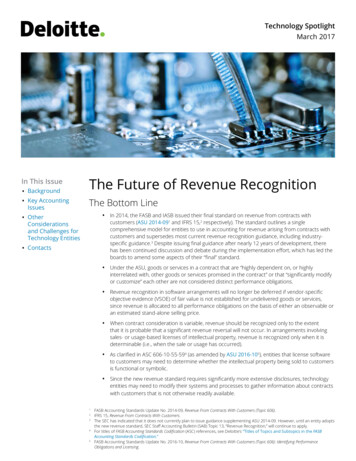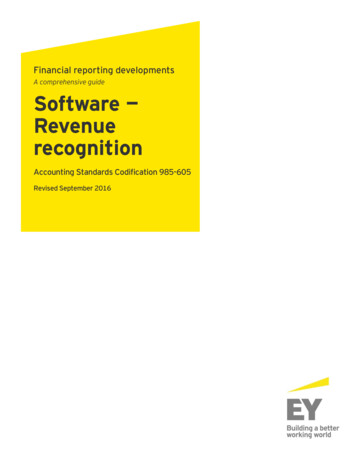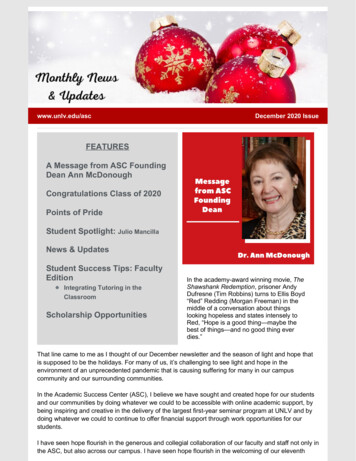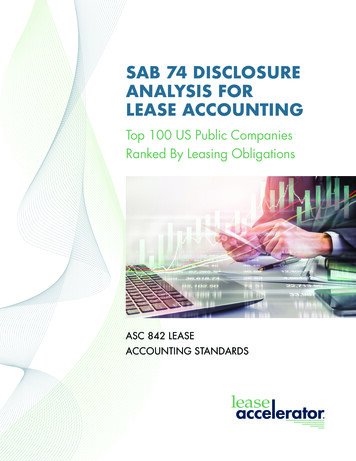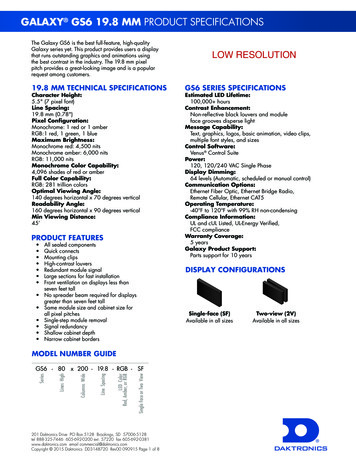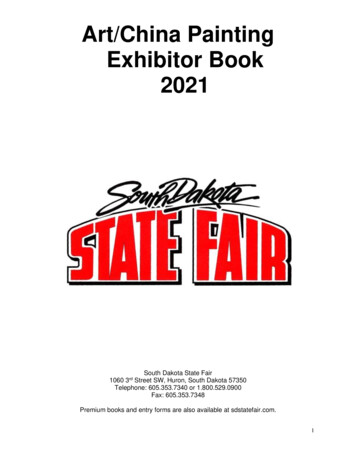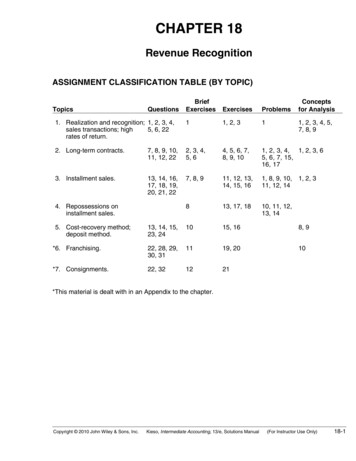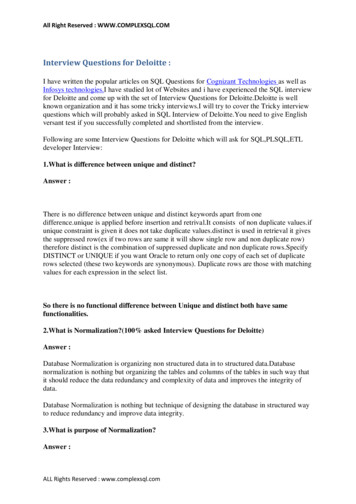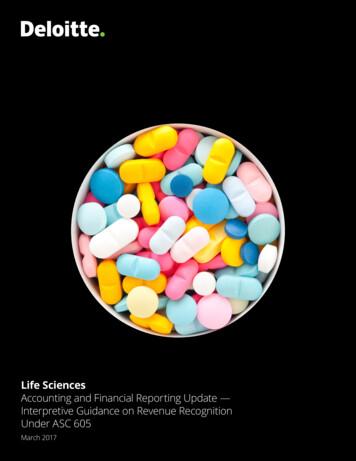
Transcription
Life SciencesAccounting and Financial Reporting Update —Interpretive Guidance on Revenue RecognitionUnder ASC 605March 2017
Revenue RecognitionIntroductionMany transactions in the life sciences industry must be carefully analyzed for revenue recognitionpurposes. Revenue recognition topics that are particularly relevant to life sciences entities includethe SAB Topic 131 requirements (e.g., sales price is fixed or determinable, collectibility is reasonablyassured); the accounting for multiple elements; the ability to estimate returns; and the accounting fordiscounts, rebates, and incentives. Further, biotech and pharmaceutical firms may sometimes encountercomplexities related to the milestone method of accounting, the proportional performance methodof revenue recognition, principal-agent considerations, license fees, contingent revenue, and up-frontpayments. Meanwhile, medical device companies may have to analyze warranties, shipping terms,consignment sales, customer financing, and the potential applicability of lease and software revenuerecognition requirements.Life sciences entities also rely heavily on collaborative arrangements to leverage expertise and managerisk. In accounting for collaborative arrangements under ASC 808, entities often also apply the revenuerecognition guidance — for example, when: Performing a principal-agent analysis for transactions with third parties. Evaluating whether transactions with the counterparty to the arrangement are viewed asrevenue activities (e.g., a biotech company performs contractual research and development(R&D) services for a pharmaceutical company under the arrangement).Determining the unit of account, measurement, and recognition of transactions with thecounterparty to the arrangement (if an entity analogizes to revenue recognition literature forsuch matters).The sections below discuss (1) guidance on some of the revenue recognition topics frequentlyencountered by life sciences entities, (2) SEC comment letter themes related to these topics,(3) anticipated changes in the life sciences industry as a result of the new revenue standard, and(4) an overview of the FASB’s project on collaborative arrangements.Industry IssuesReturns and Other Potential Adjustments to RevenueThe recognition of product revenue in the pharmaceutical (including biotechnology) industry reliesheavily on estimates and assumptions about returns and other potential adjustments to revenue.Restatements and inquiries into the revenue recognition practices in the pharmaceutical industryunderscore the need for entities to (1) focus on the criteria for recognizing revenue on the sale ofpharmaceutical products and (2) consider various factors in estimating returns, chargebacks, rebates,discounts, promotions, shelf stock adjustments, and other adjustments to revenue.1For the full titles of standards and other literature referred to in this publication, see Appendix A. For a list of abbreviations used in thispublication, see Appendix B.1
Reserves for returns may be more difficult to estimate in the pharmaceutical industry than in manyother industries. The pharmaceutical company product sales terms generally include specific returnpolicies (or policies are established through existing practice) that provide the terms under which theproduct can be returned. The product may be returned to the pharmaceutical company for a variety ofreasons. One of the most common reasons is product expiration (which often occurs 18 to 30 monthsafter product manufacturing).Chargeback and rebate arrangements are also common in the pharmaceutical industry. Pharmaceuticalcompanies often sell products to wholesalers (or distributors) under agreements containing variousterms under which the products will be managed and sold, including specific pricing and return policies.Under these agreements, wholesalers purchase products from the pharmaceutical companies for resaleto retailers (pharmacies, retail stores, or other consumer outlets), hospitals, clinics, and infusion centers.For sales made to retailers, a wholesaler typically sells a product at wholesaler acquisition cost (WAC)plus a small markup. The retailer then sells the product to the ultimate consumer, who pays for theproduct directly or provides for payment through some type of insurance program (such as a managedcare or governmental program). The price paid by the ultimate consumer (through a combination ofcopays and insurance coverage) is often less than the price paid by the retailer to the wholesaler. As aresult, retailers submit a rebate claim to the manufacturer for the difference between the price paid bythe retailer and the negotiated health insurance cost of the product.2For sales made to hospitals, clinics, and certain infusion centers, a wholesaler typically sells a product ata price negotiated by the entity (or through an intermediary, such as a group purchasing organization)and the pharmaceutical company. Because wholesalers purchase the product from the manufacturer atWAC but sell the product at a discounted price to their customers, wholesalers will “charge back” to thepharmaceutical company the difference between the wholesalers’ cost and the lower price at which theproduct was sold to the entity.The discussion below gives an overview of the revenue recognition criteria applicable to arrangementsinvolving a right of return, chargebacks, or rebates, including accounting considerations related to thesale of pharmaceutical products under these types of arrangements.Revenue Recognition When a Right of Return ExistsAs noted above, pharmaceutical companies generally give the buyer the ability to return a productunder the terms of the sale agreement. ASC 605 provides guidance on how entities should accountfor sales of products when the buyer has a return privilege, whether as a matter of contract or inaccordance with existing practice. ASC 605-15-25-1 specifies criteria for recognizing revenue when aright of return exists:ASC 605-1525-1 If an entity sells its product but gives the buyer the right to return the product, revenue from the salestransaction shall be recognized at time of sale only if all of the following conditions are met:a. The seller’s price to the buyer is substantially fixed or determinable at the date of sale.b. The buyer has paid the seller, or the buyer is obligated to pay the seller and the obligation is notcontingent on resale of the product. . . .2The actual submission process for claiming a rebate varies depending on the type of health coverage. For example, in managed markets,pharmacy benefit managers are commonly used, whereas for governmental programs, the claims are typically submitted by the states (often withthe aid of a managed care plan, which acts as an administrator).2
ASC 605-15 (continued)c. The buyer’s obligation to the seller would not be changed in the event of theft or physical destruction ordamage of the product.d. The buyer acquiring the product for resale has economic substance apart from that provided by theseller. . . .e. The seller does not have significant obligations for future performance to directly bring about resale ofthe product by the buyer.f.The amount of future returns can be reasonably estimated . . . .Sales revenue and cost of sales that are not recognized at time of sale because the foregoing conditions arenot met shall be recognized either when the return privilege has substantially expired or if those conditionssubsequently are met, whichever occurs first.While all of the above criteria must be met for revenue to be recognized, the criteria in ASC 605-1525-1(a) and ASC 605-15-25-1(f) require entities to use significant judgment in determining whento recognize revenue for products sold under many pharmaceutical arrangements. If a companydetermines that it cannot reasonably estimate returns, it cannot recognize revenue until the right ofreturn expires or a reasonable estimate of returns can be made. Similarly, if a company determinesthat the price of the product is not determinable upon shipment to the wholesaler because itcannot estimate chargebacks and rebates, revenue would have to be deferred until the price can bedetermined. In both instances, such a determination requires careful consideration of all facts andcircumstances that affect the sale of the product.Ability to Reasonably Estimate ReturnsUnder ASC 605-15-25-1(f), an entity must be able to make a reasonable estimate regarding futurereturns to recognize revenue upon shipment of the product (provided that the other requirementsof ASC 605 are met). ASC 605-15-25-3 indicates that the ability to make such an estimate depends onmany factors and notes that the following factors may impair this ability:a. The susceptibility of the product to significant external factors, such as technological obsolescence orchanges in demandb. Relatively long periods in which a particular product may be returnedc. Absence of historical experience with similar types of sales of similar products, or inability to apply suchexperience because of changing circumstances, for example, changes in the selling entity’s marketingpolicies or relationships with its customersd. Absence of a large volume of relatively homogeneous transactions.As noted in ASC 605-15-25-4, while the existence of one or more of the factors listed in ASC 605-15-25-3may not be sufficient to prevent an entity from making a reasonable estimate, other factors may preventan entity from doing so. ASC 605-10-S99-1 discusses estimates and changes in estimates and providesthe following additional factors to consider that may affect or preclude an entity’s ability to make areasonable and reliable estimate of product returns: Significant increases, or excess levels of inventory, in a distribution channel (sometimes referredto as “channel stuffing”). Lack of “visibility” into, or the inability to determine or observe, the levels of inventory in adistribution channel and the current level of sales to end users. Expected introductions of new products that may result in the technological obsolescence, andlarger than expected returns, of current products.3
The significance of a particular distributor to the registrant’s (or a reporting segment’s) business,sales, and marketing. The newness of a product. Other factors that affect market demand and changing trends in that demand for theregistrant’s products.The introduction of competitors’ products with superior technology or greater expected marketacceptance.In addition, the Interpretive Response to Question 4 of SAB Topic 13.A.4(b) discusses the SEC staff’s viewon how long a history is necessary to estimate returns in a product sale transaction within the scope ofASC 605 and states:The staff does not believe there is any specific length of time necessary in a product transaction. However,[ASC] 605-15 states that returns must be subject to reasonable estimation. Preparers and auditors should beskeptical of estimates of product returns when little history with a particular product line exists, when thereis inadequate verifiable evidence of historical experience, or when there are inadequate internal controlsthat ensure the reliability and timeliness of the reporting of the appropriate historical information. Start-upcompanies and companies selling new or significantly modified products are frequently unable to develop therequisite historical data on which to base estimates of returns.Further, the Interpretive Response to Question 5 of SAB Topic 13.A.4(b) discusses the SEC staff’s viewwhen a company selling products subject to a right of return concludes that it cannot reasonablyestimate the actual return rate because of its limited history but can conservatively estimate themaximum possible returns:If a reasonable estimate of future returns cannot be made, [ASC] 605-15 requires that revenue not berecognized until the return period lapses or a reasonable estimate can be made. Deferring revenue recognitionbased on the upper end of a wide range of potential return rates is inconsistent with the provisions of [ASC]605-15. [Footnote omitted]While not all of the factors in ASC 605 may apply directly to the sale of pharmaceutical products, many ofthe factors could significantly influence whether the product is ultimately returned. The following factorsspecific to the pharmaceutical industry could significantly affect the ability to estimate returns: Period in which returns can occur. Current stage in the product life cycle (i.e., initial product launch vs. end/maturity of product life).Experiences with products (or the inability to apply such experiences to current products).Potential channel stuffing.Lack of information about product levels and age of product in the distribution channel.Predictability of market conditions and competition (e.g., competitive entry of a similar or genericproduct).Historical, current, and projected demand.The period and terms for product returns attributable to expiration may present particular challenges.The terms may specify, for example, that expiration returns may be made no sooner than 6 monthsbefore expiration and no later than 12 months after expiration. Under these common return practices,which may generate most of the returns, an entity may have to use significant judgment and may needsignificant data to reasonably estimate the returns reserve. Further, a review of subsequent returnactivity before issuance of the financial statements might be less useful for pharmaceutical companies4
than it would be for most companies. This is because the expiration returns observed (e.g., in the first 2months after year-end) might be related to sales that took place no sooner than 24 months earlier, if weassume a product life of 30 months from the date of sale.Fully understanding the terms and conditions under which each product is being sold is key todetermining whether revenue is being accounted for appropriately. The mere existence of factors citedin ASC 605 does not necessarily result in the inability to estimate returns. However, while there are nobright lines, sufficient evidence should exist to support the conclusion regarding the impact of each ofthese factors on the ability to estimate future returns. If there is not sufficient evidence of this ability,revenue should not be recognized until the right of return expires or there is sufficient evidence toestimate future returns.Evaluating these factors for new product launches in the pharmaceutical industry may be evenmore challenging. The amount of historical information and evidence to support the estimatesand assumptions regarding returns could be reduced depending on whether the product is (1) amodification of an existing product, (2) similar to other products in the market (i.e., an “analog”), or(3) a completely new product. Obtaining sufficient evidence for new products may be particularly difficultwhen the company does not have a relevant history for an analog or a clear competitive advantagethat allows for more predictable sales. As noted above, the availability of sufficient evidence to supportthese estimates and assumptions is an important factor in having the ability to recognize revenue.Further, when using an analog to aid in the estimation of returns, life sciences entities are encouragedto document the basis for their conclusions that the analog is similar to the product being sold. Typically,this documentation should reflect that the analog is part of a similar therapeutic class, provides a similarmechanism of treatment, and targets similar customers and markets.Ability to Reasonably Estimate Chargebacks and RebatesIn addition to estimating returns, entities must be able to make a reasonable estimate of potentialadjustments to the price of the product, such as chargebacks and rebates. Although ASC 605 does notspecifically address the accounting for pricing adjustments, ASC 605-15-25-1 requires the seller’s priceto the buyer to be fixed or determinable for revenue to be recognized. As with the requirement of ASC605-15-25-1(f), whether the price is determinable depends on the entity’s ability to reasonably estimatefuture adjustments to the amount billed for the product. This ability may be affected by many of thesame factors that affect returns. Although ASC 605 does not provide specific factors to consider, thefactors used in the evaluation of returns should also be used in the evaluation of whether the price isfixed or determinable, to the extent that those factors are applicable. The following factors may also behelpful in such an evaluation: Existence of product-specific historical information regarding chargebacks and rebates. Information regarding the specific retailer and consumer product sales mix (to understandwhich customer pricing arrangement is applicable). Availability and specificity of customer inventory levels.Availability and specificity of customer-specific pricing information (including contractualarrangements with retailers, insurance providers, or governmental agencies).5
As with product returns, the nonexistence of one or more of the above factors, or the existence ofone or more of the factors in ASC 605, does not necessarily result in the inability to estimate pricingadjustments. However, sufficient evidence should exist to ensure that the impact of these factors orsimilar factors does not change the conclusion that the price is fixed or determinable. If sufficientevidence does not exist to support such a conclusion, revenue should not be recognized until the pricecan be determined.Thinking It ThroughThis guidance does not apply to potential adjustments to the price of the product that are basedon future performance obligations or other contingencies. Such adjustments may be deemedcontingent revenue and are subject to the guidance in ASC 605-15-25-1(e) or other authoritativeliterature.Pay-for-Performance ArrangementsPay for performance in health care gives financial incentives to clinicians for better health outcomes.Clinical outcomes, such as longer survival, can be difficult to measure, so pay-for-performance systemsusually measure process outcomes. Also known as “value-based purchasing,“ this payment modelrewards physicians, hospitals, medical groups, and other health care providers for meeting certainperformance measures for quality and efficiency. It penalizes caregivers for poor outcomes, medicalerrors, or increased costs. For example, if, after a defined treatment period, a patient does not exhibitthe predetermined objective criteria, the drug manufacturer could be required to reimburse all or aportion of the amounts originally received upon sale of the drug.QuestionCan a vendor that enters into a pay-for-performance arrangement record revenue at the time of initialsale with a reserve for the portion of sales that it expects will not meet the previously determinedcriteria, or should revenue be deferred until the close of the refund period?AnswerRevenue may be recognized at the time of initial sale if the vendor can demonstrate that it has sufficienthistorical basis to estimate the refunds to which the customer will be entitled. If the vendor does nothave a company-specific historical basis to estimate refunds, revenue should be deferred until the closeof the predetermined contingency period.Multiple-Element ArrangementsIdentifying Deliverables in a Multiple-Element ArrangementASC 605-25-15-2 states that the guidance in ASC 605-25 applies to “[a]ll deliverables (that is, products,services, or rights to use assets) within contractually binding arrangements (whether written, oral, orimplied . . . ).” Further, ASC 605-25-25-4 indicates that a “vendor shall evaluate all deliverables in anarrangement to determine whether they represent separate units of accounting.”6
The term “deliverable,” however, is not defined. Accordingly, an entity must use judgment in determiningwhether an item in a multiple-element arrangement constitutes a deliverable. Throughout anarrangement, a vendor may commit to various “significant” performance obligations (e.g., obligationsto provide products, provide services, or grant licenses), each of which may be likely to constitute adeliverable. An entity may also have various “less significant” or “ancillary” performance obligations underthe arrangement. In addition, the terms of an arrangement could generally provide the parties withcertain protective and other rights, such as a right to participate in a joint governance activity. The entitymay need to consider such obligations to determine whether, on the basis of the specific facts andcircumstances, they represent deliverables.QuestionWhat should a vendor consider when determining whether an item in a multiple-element arrangementconstitutes a deliverable?AnswerA vendor should consider the following as it analyzes an arrangement — viewed from the perspective ofthe customer (i.e., the other party to the arrangement) — to identify potential deliverables: Whether an item in the arrangement requires a distinct action from the vendor. Whether the vendor’s failure to deliver an item results in (1) the customer’s receiving a full orpartial refund, (2) the vendor’s incurring a contractual penalty, or (3) both. Whether all performance obligations (e.g., an obligation to provide a product, service,or right, either at a point in time or over the term of the arrangement) have beenidentified — particularly performance obligations that (1) may be considered ancillary to the“primary” product(s), service(s), or right(s) being sold or (2) do not have explicit monetary valuesassigned to them under the terms of the arrangement. The degree to which an item is essential to the functionality of other products, services, or rightsbeing sold. Whether the customer considers an item significant or of value separately from otherdeliverables.Whether the exclusion of the item from, or the inclusion of the item in, the arrangement wouldcause the arrangement fee to vary by more than an insignificant amount.This list is not all-inclusive. When identifying deliverables, entities should evaluate the facts andcircumstances of each arrangement. Notably, ASC 605-25 does not contain a materiality threshold foridentifying deliverables in a multiple-element arrangement.An example of an ancillary service obligation that could be considered a deliverable (that may or maynot have a monetary value assigned to it) is an obligation to participate on a joint steering committee(or committees) throughout the term of the arrangement or without a defined term. Such an obligationis common in collaborative arrangements — particularly in the biotechnology and pharmaceuticalindustries. However, sometimes an entity may assess the substance and timing of the participation andconclude that such joint steering committee participation does not constitute a deliverable (i.e., theparticipation represents a right to joint governance for the mutual protection of each party’s interestrather than a service obligation). For example, the vendor may have the contractual right to withdrawfrom, and later rejoin, the joint steering committee without any financial consequences.7
Once all deliverables in a multiple-element arrangement have been identified, a vendor should applythe provisions of ASC 605-25-25-5 to determine whether to consider each deliverable a separate unit ofaccounting.ExampleCompany B enters into an arrangement with a customer to deliver highly specialized diagnosticequipment. The arrangement requires that upon installation of the equipment, all testing of theequipment must occur at the customer’s location. Company B has previously sold the same equipmentseparately to other customers, and other vendors can perform the installation of the equipment.When determining what elements of the arrangement constitute deliverables, B would assessthe equipment, installation, testing, and other contractual terms of the arrangement. Company Bdetermines that the equipment and the installation are both deliverables because both are soldseparately in the marketplace.Company B would consider the factors above, among others, when determining whether the testingrepresents a deliverable. If, during the testing of the product, B allowed the customer’s employees toconsult its installation technicians about key troubleshooting techniques associated with the equipmentand the customer acquired knowledge during that process, B may conclude that the testing is adeliverable that it must evaluate under ASC 605-25. That is, B may conclude that the testing is important,has value to the customer, and therefore would cause the arrangement fee to vary by more than aninsignificant amount.Conversely, if the testing of the equipment was a standardized process that is considered perfunctoryand results in no transfer of knowledge to the customer, B may conclude that the testing (1) is simplya quality-control function inseparable from the equipment itself and (2) should not be evaluated as aseparate deliverable under ASC 605-25.Contingent DeliverablesQuestionIs a contingency in a multiple-element revenue arrangement a deliverable that an entity should evaluateunder ASC 605-25?AnswerA contingency in a revenue arrangement may represent a potential deliverable that may be difficultto analyze under ASC 605-25. The EITF discussed this topic during its deliberations of the guidance(codified by ASU 2009-13) but ultimately decided not to address contingencies in an arrangement withmultiple deliverables, observing that accounting conclusions on this topic are highly dependent onindividual facts and circumstances.The “Issue 08-1 Working Group,” which advised the EITF on this topic, described a contingent deliverableas a revenue-generating activity that is contingent on the occurrence of a future event not exclusivelywithin the control of the customer. If the future event occurs, the vendor is required by the terms ofthe arrangement to deliver specified products or services. In describing contingent deliverables, theworking group noted that such deliverables can be contingent on (1) the actions of a party unrelated tothe revenue arrangement (such as a governmental agency), (2) the vendor’s actions, or (3) a combinationof both. In some industries and arrangements, contingent deliverables may be prevalent and representdeliverables with considerable value.8
The examples below illustrate contingencies that could be considered deliverables under ASC 605-25.Example 1Company B is a biotech company that has developed a new technology for monitoring and testingdiabetic individuals. Company B grants Customer X a five-year license to its technology. The terms ofthe license agreement do not require B (i.e., B is not obligated) to perform any additional R&D activities.However, B agrees (i.e., B has a contingent obligation) that if improvements to its technology are madeduring the next two years, it will provide X with a license to the updated technology on a when-and-ifavailable basis. Any new license granted to X will terminate at the same time as the original five-yearlicense.On the basis of all of the facts and circumstances, B determines that the obligation to provide a licensefor improvements to its technology on a when-and-if-available basis represents a deliverable that mustbe evaluated and accounted for under ASC 605-25.Example 2Company C enters into an arrangement in which it agrees (i.e., has an obligation) to provide R&Dservices to Customer Y on a best-efforts basis for three years. If a commercially viable product isdeveloped as a result of those services, C agrees to manufacture 100 units of the product and deliverthem (i.e., has a contingent obligation) to Y. The manufacturing process performed by C is novel sincesimilar manufacturing capabilities are not available in the marketplace. Customer Y agrees to pay C 1 million for the R&D services.On the basis of all of the facts and circumstances, C determines that the obligation to manufacture anddeliver 100 units if a commercially viable product is developed represents a deliverable that must beevaluated and accounted for under ASC 605-25.Optional PurchasesQuestionAn optional purchase is a term in an arrangement that gives a customer the option to purchaseproducts or services in the future. Is an optional purchase a deliverable that an entity should evaluateunder ASC 605-25?AnswerIt depends. If a revenue-generating arrangement contains an option to buy products or services in thefuture and the substance of the arrangement is that the customer truly can elect whether to purchaseany of those products or services, the option should be evaluated as a separate arrangement and not asa deliverable of the original arrangement. An entity should evaluate the substance of an arrangement indetermining whether an optional purchase of future products or services represents a deliverable.An entity should analyze all relevant facts and circumstances in determining the substance of thearrangement, such as whether the contractual option to purchase the product or service in the futureis truly optional to the customer. If, in substance, the option to buy the future product or service isnot truly optional because the customer has no choice but to purchase the future product or service,the optional purchase of future products or services would be considered a deliverable of the originalarrangement. For example, if an arrangement gave a customer the option to purchase future products9
or services and those future products and services were necessary for the intended use of the deliveredproduct and not readily obtainable from another party, the optional purchase of future products andservices would be considered a deliverable of the original arrangement.If an arrangement’s contractual terms represent options to purchase future products and services inwhich the quantity ultimately purchased is variable but the custom
Revenue Recognition Introduction Many transactions in the life sciences industry must be carefully analyzed for revenue recognition purposes. Revenue recognition topics that are particularly relevant to life sciences entities include the SAB Topic 131 requirements (e.g., sales price is fixed or determinable, collectibility is reasonably
